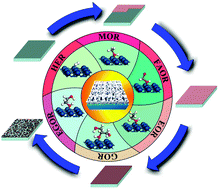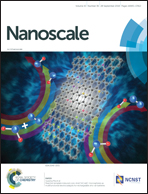A self-supported nanoporous PtGa film as an efficient multifunctional electrocatalyst for energy conversion†
Abstract
Pt-based nanomaterials have been widely investigated as efficient electrocatalysts for energy conversion reactions such as small organic molecule oxidation and hydrogen evolution, but are mainly limited to alloys of Pt with transition metals. Herein, a new PtGa electrocatalyst with unique nanoporous architecture and a self-supported feature (np-PtGa) was fabricated via a liquid Ga-assisted dealloying strategy. Owing to the unique nanoporous structure and alloying effect by the introduction of Ga, the np-PtGa alloy exhibits excellent electrocatalytic activities towards the electrooxidation of methanol, ethanol, ethylene glycol, glycerol, and formic acid, which are three orders of magnitude higher than those of the benchmark Pt foil. Moreover, our np-PtGa alloy displays extraordinary catalytic activities towards the hydrogen evolution reaction in both acidic and alkaline environments. Impressively, the overpotential of np-PtGa is as low as 50 mV at 10 mA cm−2 with a Tafel slope of 55 mV dec−1 in 1 M KOH, outperforming most of the recently reported electrocatalysts. Density functional theory calculations demonstrate that the downshift of the d-band center caused by the Ga 4p/Pt 5d orbital hybridization and compressive stress could weaken the adsorption of intermediate species and well rationalize the enhanced electrocatalytic performance of np-PtGa.



 Please wait while we load your content...
Please wait while we load your content...